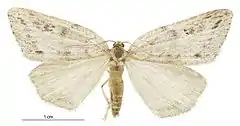Pseudocoremia cineracia
Pseudocoremia cineracia is a species of moth in the family Geometridae. It is endemic to New Zealand. It is classified as Nationally Vulnerable by the Department of Conservation.
| Pseudocoremia cineracia | |
|---|---|
 | |
| Male | |
 | |
| Female | |
| Scientific classification | |
| Kingdom: | |
| Phylum: | |
| Subphylum: | |
| Class: | |
| Order: | |
| Family: | |
| Tribe: | |
| Genus: | |
| Species: | P. cineracia |
| Binomial name | |
| Pseudocoremia cineracia | |
| Synonyms[3] | |
| |
Taxonomy
This species was first described by George Howes in 1942 from specimens obtained at Moke Lake[4] and taken in January[5] and February.[4] Howes named it Selidosema cineracia. This name was also used when the species was discussed by George Vernon Hudson in 1950.[6] In 1988 John S. Dugdale assigned the species to the genus Pseudocoremia.[3] This classification of the species into Pseudocoremia is regarded as unsatisfactory.[2] As such the species is also currently known as Pseudocoremia (s.l.) cineracia.[2] The hototype specimen is held at the Museum of New Zealand Te Papa Tongarewa.[5]
Description
The larvae are coloured grey.[7]
Howes described the adult male of the species as follows:
Wing expanse, 30 mm. Head and thorax ash-grey. Antennae grey-brown. Abdomen ochreous. Forewings pale brownish- ochreous-brown. Strongly arched at base, then almost straight to apex. Termen slightly bent inwards from centre to tornus. Basal line faintly indicated by a short dark line below centre of wing, with a dark streak below centre outwardly angled towards dorsum. Claviform shows as a slight dot with a surrounding darker suffusion. Reniform faintly shown clouded with dark brown with a small dark dot in centre. Submarginal very slightly pale - the terminal line indistinct, with a terminal series of small dark dots. Cilia ochreous - very short. Veins faintly indicated in grey. Lower wings pale ochreous without markings and with a definite incurving at about one-third along termen. Cilia light ochreous and very short. Underside evenly ochreous white, the hindwings a shade lighter. No appearance of lunule.[4]
Distribution
This species is endemic to New Zealand.[2][8] The species range of this moth is Mackenzie, Central Otago and Otago Lakes.[9] Other than its type locality, this species occurs at Stony Beach at Okains Bay,[10] Big Spur Creek & Cluden Stream at Cluden Station in Otago[11] and Kawarau Gorge.[7]
Biology and host species
The host species of this moth is Olearia odorata.[9] The species is attracted to sugar lures.[4] The adults are on the wing August until June with the species being more common in September.[7]
Habitat
P. cineracia inhabits montane shrublands at an altitude of between 150-850m.[7]
Conservation status
This species has been classified under the New Zealand Threat Classification system as being Nationally Vulnerable.[1] P. cineracia is classified as nationally vulnerable partially because of its reliance on its host plant which is suffering a decline as a result of habitat destruction.[7]
References
| Wikimedia Commons has media related to Pseudocoremia cineracia. |
- Hoare, R.J.B.; Dugdale, J.S.; Edwards, E.D.; Gibbs, G.W.; Patrick, B.H.; Hitchmough, R.A.; Rolfe, J.R. (2017). Conservation status of New Zealand butterflies and moths (Lepidoptera), 2015 (PDF). Wellington, New Zealand: New Zealand Department of Conservation. p. 7. ISBN 9781988514383.
- "Pseudocoremia cineracia (Howes, 1942)". www.nzor.org.nz. Landcare Research New Zealand Ltd. Retrieved 7 May 2018.
- Dugdale, J. S. (1988). "Lepidoptera - annotated catalogue, and keys to family-group taxa" (PDF). Fauna of New Zealand. 14: 96 – via Landcare Research New Zealand Ltd.
- Howes, George (1942). "Lepidoptera". Transactions and Proceedings of the Royal Society of New Zealand. 71: 277–278.
- "Pseudocoremia cineracia (Howes, 1942)". collections.tepapa.govt.nz. Retrieved 2018-05-07.
- Hudson, G. V. (1950). Fragments of New Zealand entomology. - a popular account of all New Zealand cicadas. The natural history of the New Zealand glow-worm. A second supplement to the butterflies and moths of New Zealand and notes on many other native insects. Wellington: Ferguson & Osborne Ltd. p. 92. Retrieved 7 May 2018.
- Pawson, SM; Emberson, RM (2000). "Appendix A". The conservation status of invertebrates in Canterbury. Wellington: Department of Conservation. p. 49. hdl:10182/1658. ISSN 1171-9834.
- Gordon, Dennis P., ed. (2010). New Zealand inventory of biodiversity. Volume two. Kingdom animalia : chaetognatha, ecdysozoa, ichnofossils. Vol. 2. Christchurch, N.Z.: Canterbury University Press. p. 459. ISBN 9781877257933. OCLC 973607714.
- Patrick, Brian; Dugdale, John S. (2000). Conservation status of the New Zealand Lepidoptera (PDF). Wellington, New Zealand: Department of Conservation. p. 28. ISBN 0478218672.
- Hogan, Debbie (6 June 2015). "Christchurch District Plan. Site of Ecological Significance. Stony Beach" (PDF). www.districtplan.ccc.govt.nz. Retrieved 7 May 2017.
- "Crown Pastoral Land Tenure Review. Cluden Station. Conservation Resources Report - Part 1" (PDF). www.linz.govt.nz. 2005. Retrieved 7 May 2018.
